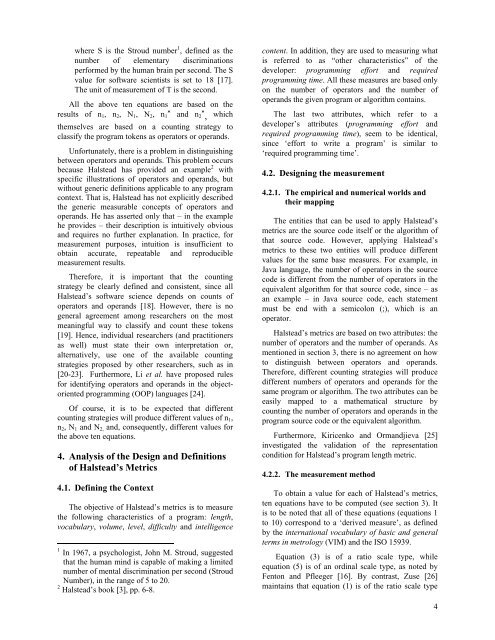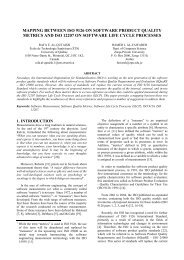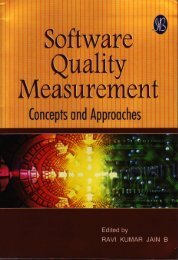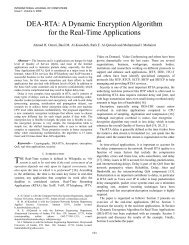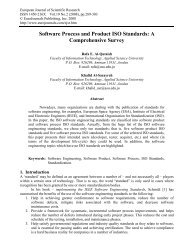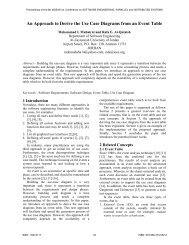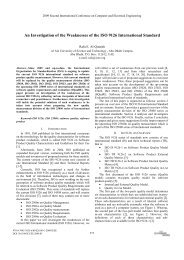An Analysis of the Design and Definitions of Halstead's Metrics
An Analysis of the Design and Definitions of Halstead's Metrics
An Analysis of the Design and Definitions of Halstead's Metrics
You also want an ePaper? Increase the reach of your titles
YUMPU automatically turns print PDFs into web optimized ePapers that Google loves.
where S is <strong>the</strong> Stroud number 1 , defined as <strong>the</strong>number <strong>of</strong> elementary discriminationsperformed by <strong>the</strong> human brain per second. The Svalue for s<strong>of</strong>tware scientists is set to 18 [17].The unit <strong>of</strong> measurement <strong>of</strong> T is <strong>the</strong> second.All <strong>the</strong> above ten equations are based on <strong>the</strong>results <strong>of</strong> n 1 , n 2 , N 1 , N 2 , n * 1 <strong>and</strong> n * 2 , which<strong>the</strong>mselves are based on a counting strategy toclassify <strong>the</strong> program tokens as operators or oper<strong>and</strong>s.Unfortunately, <strong>the</strong>re is a problem in distinguishingbetween operators <strong>and</strong> oper<strong>and</strong>s. This problem occursbecause Halstead has provided an example 2 withspecific illustrations <strong>of</strong> operators <strong>and</strong> oper<strong>and</strong>s, butwithout generic definitions applicable to any programcontext. That is, Halstead has not explicitly described<strong>the</strong> generic measurable concepts <strong>of</strong> operators <strong>and</strong>oper<strong>and</strong>s. He has asserted only that – in <strong>the</strong> examplehe provides – <strong>the</strong>ir description is intuitively obvious<strong>and</strong> requires no fur<strong>the</strong>r explanation. In practice, formeasurement purposes, intuition is insufficient toobtain accurate, repeatable <strong>and</strong> reproduciblemeasurement results.Therefore, it is important that <strong>the</strong> countingstrategy be clearly defined <strong>and</strong> consistent, since allHalstead’s s<strong>of</strong>tware science depends on counts <strong>of</strong>operators <strong>and</strong> oper<strong>and</strong>s [18]. However, <strong>the</strong>re is nogeneral agreement among researchers on <strong>the</strong> mostmeaningful way to classify <strong>and</strong> count <strong>the</strong>se tokens[19]. Hence, individual researchers (<strong>and</strong> practitionersas well) must state <strong>the</strong>ir own interpretation or,alternatively, use one <strong>of</strong> <strong>the</strong> available countingstrategies proposed by o<strong>the</strong>r researchers, such as in[20-23]. Fur<strong>the</strong>rmore, Li et al. have proposed rulesfor identifying operators <strong>and</strong> oper<strong>and</strong>s in <strong>the</strong> objectorientedprogramming (OOP) languages [24].Of course, it is to be expected that differentcounting strategies will produce different values <strong>of</strong> n 1 ,n 2 , N 1 <strong>and</strong> N 2, <strong>and</strong>, consequently, different values for<strong>the</strong> above ten equations.4. <strong>An</strong>alysis <strong>of</strong> <strong>the</strong> <strong>Design</strong> <strong>and</strong> <strong>Definitions</strong><strong>of</strong> Halstead’s <strong>Metrics</strong>4.1. Defining <strong>the</strong> ContextThe objective <strong>of</strong> Halstead’s metrics is to measure<strong>the</strong> following characteristics <strong>of</strong> a program: length,vocabulary, volume, level, difficulty <strong>and</strong> intelligence1 In 1967, a psychologist, John M. Stroud, suggestedthat <strong>the</strong> human mind is capable <strong>of</strong> making a limitednumber <strong>of</strong> mental discrimination per second (StroudNumber), in <strong>the</strong> range <strong>of</strong> 5 to 20.2 Halstead’s book [3], pp. 6-8.content. In addition, <strong>the</strong>y are used to measuring whatis referred to as “o<strong>the</strong>r characteristics” <strong>of</strong> <strong>the</strong>developer: programming effort <strong>and</strong> requiredprogramming time. All <strong>the</strong>se measures are based onlyon <strong>the</strong> number <strong>of</strong> operators <strong>and</strong> <strong>the</strong> number <strong>of</strong>oper<strong>and</strong>s <strong>the</strong> given program or algorithm contains.The last two attributes, which refer to adeveloper’s attributes (programming effort <strong>and</strong>required programming time), seem to be identical,since ‘effort to write a program’ is similar to‘required programming time’.4.2. <strong>Design</strong>ing <strong>the</strong> measurement4.2.1. The empirical <strong>and</strong> numerical worlds <strong>and</strong><strong>the</strong>ir mappingThe entities that can be used to apply Halstead’smetrics are <strong>the</strong> source code itself or <strong>the</strong> algorithm <strong>of</strong>that source code. However, applying Halstead’smetrics to <strong>the</strong>se two entities will produce differentvalues for <strong>the</strong> same base measures. For example, inJava language, <strong>the</strong> number <strong>of</strong> operators in <strong>the</strong> sourcecode is different from <strong>the</strong> number <strong>of</strong> operators in <strong>the</strong>equivalent algorithm for that source code, since – asan example – in Java source code, each statementmust be end with a semicolon (;), which is anoperator.Halstead’s metrics are based on two attributes: <strong>the</strong>number <strong>of</strong> operators <strong>and</strong> <strong>the</strong> number <strong>of</strong> oper<strong>and</strong>s. Asmentioned in section 3, <strong>the</strong>re is no agreement on howto distinguish between operators <strong>and</strong> oper<strong>and</strong>s.Therefore, different counting strategies will producedifferent numbers <strong>of</strong> operators <strong>and</strong> oper<strong>and</strong>s for <strong>the</strong>same program or algorithm. The two attributes can beeasily mapped to a ma<strong>the</strong>matical structure bycounting <strong>the</strong> number <strong>of</strong> operators <strong>and</strong> oper<strong>and</strong>s in <strong>the</strong>program source code or <strong>the</strong> equivalent algorithm.Fur<strong>the</strong>rmore, Kiricenko <strong>and</strong> Orm<strong>and</strong>jieva [25]investigated <strong>the</strong> validation <strong>of</strong> <strong>the</strong> representationcondition for Halstead’s program length metric.4.2.2. The measurement methodTo obtain a value for each <strong>of</strong> Halstead’s metrics,ten equations have to be computed (see section 3). Itis to be noted that all <strong>of</strong> <strong>the</strong>se equations (equations 1to 10) correspond to a ‘derived measure’, as definedby <strong>the</strong> international vocabulary <strong>of</strong> basic <strong>and</strong> generalterms in metrology (VIM) <strong>and</strong> <strong>the</strong> ISO 15939.Equation (3) is <strong>of</strong> a ratio scale type, whileequation (5) is <strong>of</strong> an ordinal scale type, as noted byFenton <strong>and</strong> Pfleeger [16]. By contrast, Zuse [26]maintains that equation (1) is <strong>of</strong> <strong>the</strong> ratio scale type4


